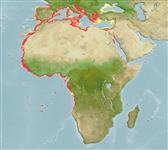分類 / Names
俗名 | 同種異名 | Catalog of Fishes(屬, 種) | ITIS | CoL | WoRMS | Cloffa
Elasmobranchii
板鰓亞綱 (鯊魚與魟魚) (sharks and rays) >
Torpediniformes (Electric rays)
電鰩目 (Electric rays) >
Torpedinidae (Electric rays)
電 (Electric rays)
Etymology: Torpedo: Latin, torpere = be sluggish (Ref. 45335).
More on author: Linnaeus.
Environment: milieu / climate zone / depth range / distribution range
生態學
海洋 居於水底的; 深度上下限 2 - 400 m (Ref. 4430), usually ? - 70 m (Ref. 27000). 深水域; 48°N - 18°S, 19°W - 38°E (Ref. 114953)
Eastern Atlantic: southern Bay of Biscay and throughout the Mediterranean to Angola. Most common in tropical waters.
東大西洋: 比斯開灣南部與在地中海到安哥拉各處。 常見於熱帶水域。
大小 / 重量 / 年齡
Maturity: Lm ? range ? - ? cm
Max length : 60.0 cm TL 雄魚/尚未辨別雌雄; (Ref. 13417); 41.0 cm TL (female); common length : 30.0 cm TL 雄魚/尚未辨別雌雄; (Ref. 13417); common length :39 cm TL (female)
Found on soft bottoms, usually inshore but occasionally deeper. Feeds on small fishes and also benthic invertebrates. Ovoviviparous, with 3-21 in a litter (Ref. 12951, Ref. 114953). Size at birth 9 cm (Ref. 12951). Capable of inflicting a severe shock of up to 200 volts.
棲息於軟質底部了, 通常近海但是偶然比較深的。 吃小魚以及底棲的無脊椎動物。 卵胎生的, 有三個 -21 一胎.(參考文獻 12951) 出生時的大小 9 公分。 (參考文獻 12951) 能夠施放向上到的嚴重驚嚇 200 伏特。
Life cycle and mating behavior
成熟度 | 繁殖 | 產卵場 | 卵 | 孕卵數 | 仔魚
Exhibit ovoviparity (aplacental viviparity), with embryos feeding initially on yolk, then receiving additional nourishment from the mother by indirect absorption of uterine fluid enriched with mucus, fat or protein through specialised structures (Ref. 50449).東大西洋: 比斯開灣南部與在地中海到安哥拉各處。 常見於熱帶水域。
Bauchot, M.-L., 1987. Raies et autres batoides. p. 845-886. In W. Fischer, M.L. Bauchot and M. Schneider (eds.) Fiches FAO d'identificationpour les besoins de la pêche. (rev. 1). Mèditerranée et mer Noire. Zone de pêche 37. Vol. II. Commission des Communautés Européennes and FAO, Rome. (Ref. 3261)
人類使用
漁業: 沒有興趣; 水族館: 公眾的水族館
更多資訊
參考文獻養殖養殖資訊品種遺傳學Electrophoreses遺傳率疾病加工NutrientsMass conversion
合作者照片Stamps, Coins Misc.聲音神經毒速度泳型鰓區Otoliths腦重體重比眼睛色素
工具
特別的報告
下載 XML
網路資源
Estimates based on models
Preferred temperature (Ref.
123201): 13 - 20.9, mean 15.6 °C (based on 78 cells).
Phylogenetic diversity index (Ref.
82804): PD
50 = 0.5005 [Uniqueness, from 0.5 = low to 2.0 = high].
Bayesian length-weight: a=0.01514 (0.01155 - 0.01983), b=2.95 (2.87 - 3.03), in cm total length, based on LWR estimates for this species (Ref.
93245).
營養階層 (Ref.
69278): 4.5 ±0.0 se; based on diet studies.
Generation time: 10.0 ( na - na) years. Estimated as median ln(3)/K based on 1
growth studies.
回復力 (Ref.
120179): 低的, 最小族群倍增時間4.5 - 14 年 (K=0.11).
Fishing Vulnerability (Ref.
59153): High to very high vulnerability (65 of 100).
Nutrients (Ref.
124155): Calcium = 9.24 [1.57, 48.04] mg/100g; Iron = 0.362 [0.085, 1.136] mg/100g; Protein = 17.3 [12.8, 20.6] %; Omega3 = 0.419 [0.157, 0.972] g/100g; Selenium = 9.34 [2.94, 27.66] μg/100g; VitaminA = 20 [4, 94] μg/100g; Zinc = 0.311 [0.151, 0.581] mg/100g (wet weight);
